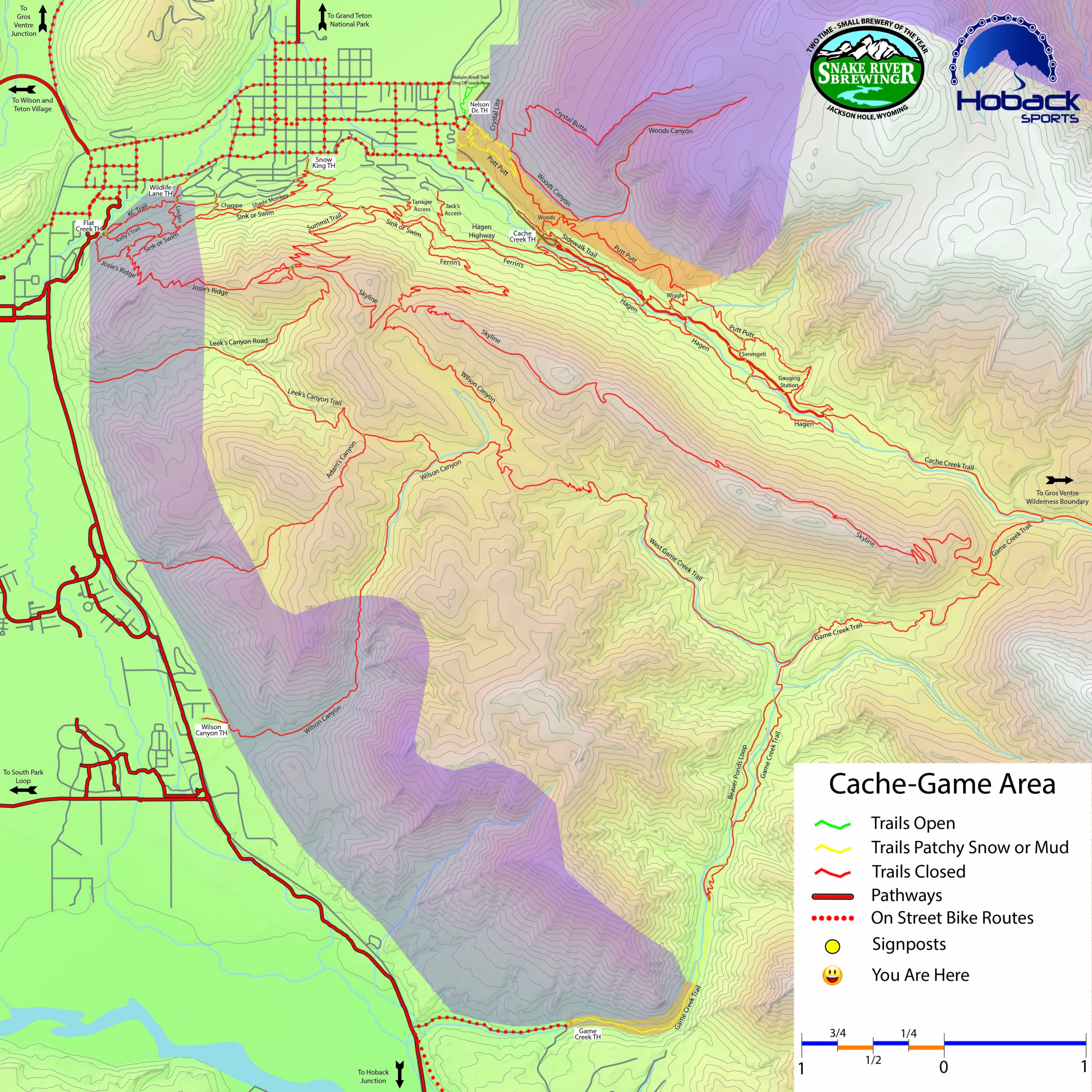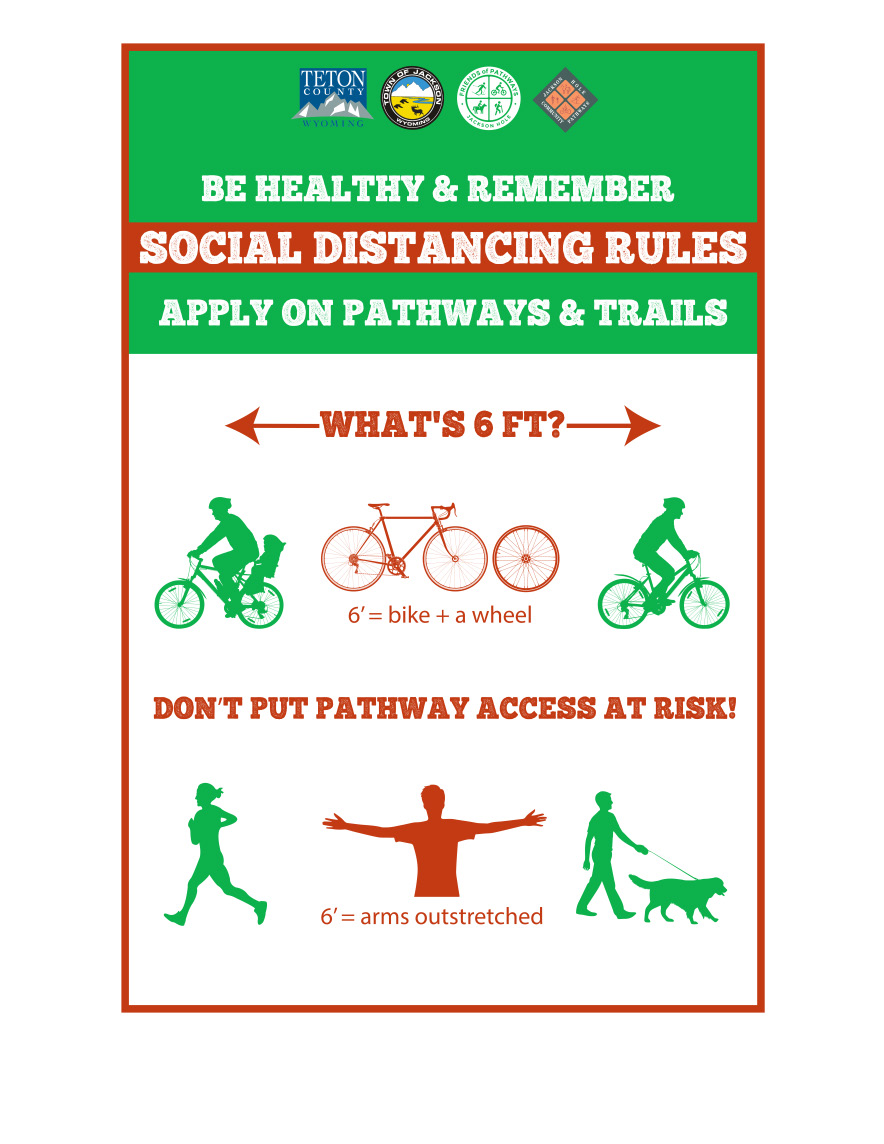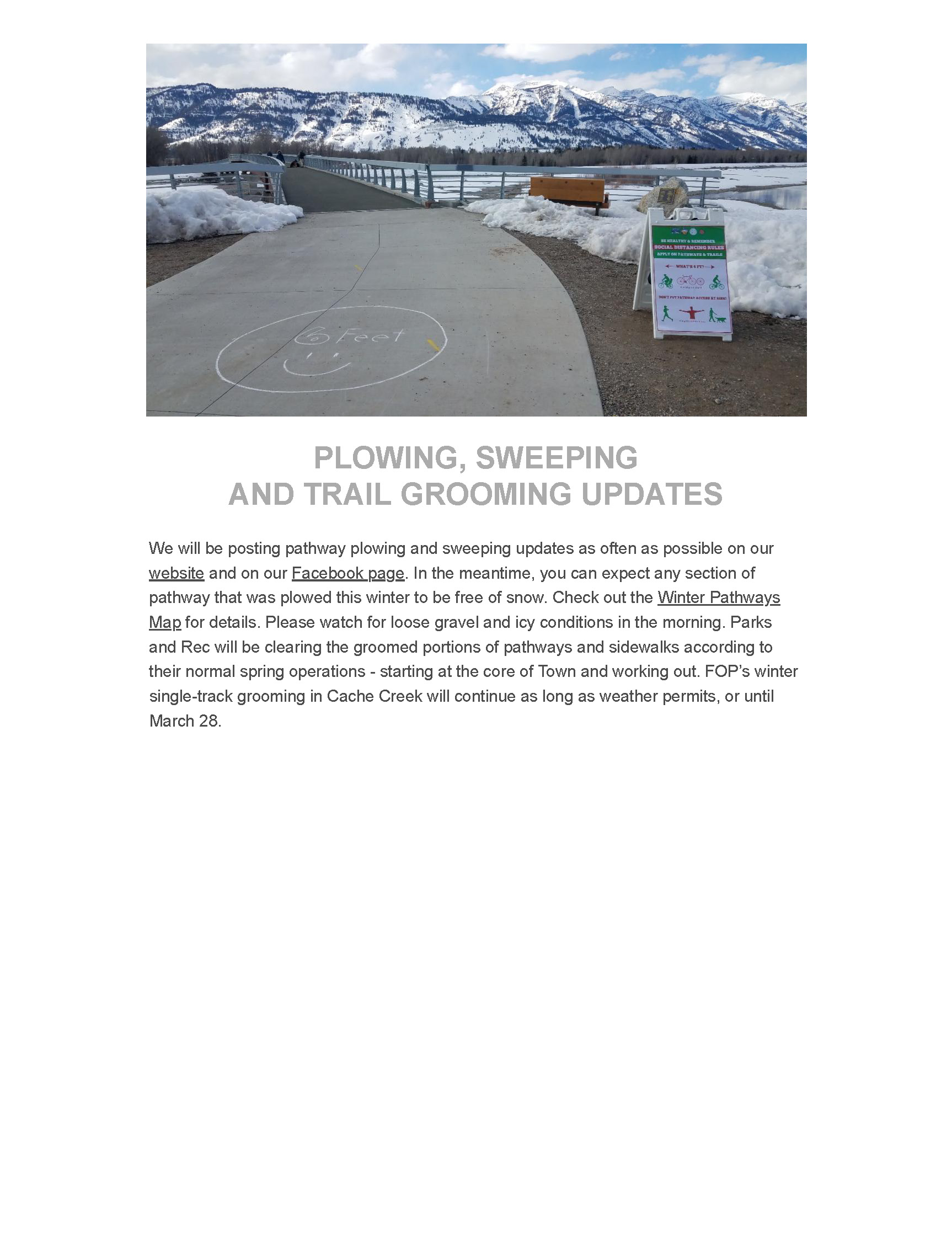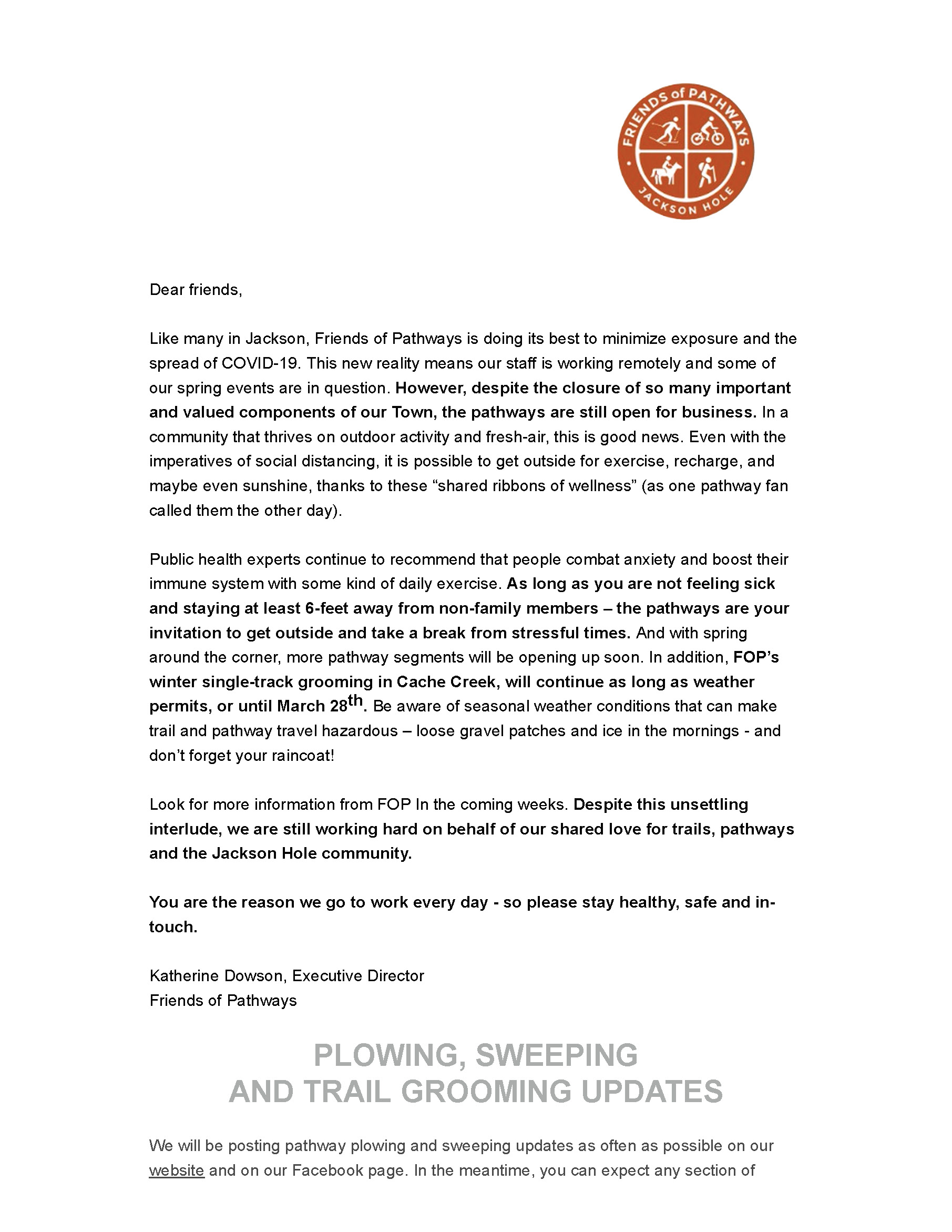March 31, 2020
Derek Ibarguen, Acting Forest Supervisor
Bridger-Teton National Dorest
P.O. Box 1888
340 North Cache Street
Jackson, WY 83001
Dear Derek,
On behalf of Friends of Pathways (FOP), we are submitting comments regarding the On-Mountain
Improvements Project for Snow King Mountain Resort. FOP has partnered with the Bridger-Teton
National Forest (BTNF) over the last 20 years to build and maintain sustainable trails and promote
good trail etiquette on the 130-mile front-country trail system, including the Snow King area. We
believe that Snow King Resort is an appropriate place to add new trails and improve existing trails to
provide close-to-home access to the national forest.
We support the following improvements proposed by Snow King Resort as they are in keeping with
the BTNF’s desired future conditions and align with a key component of FOP’s mission to promote
healthy recreation in Jackson Hole.
1. Vertical Staircase
FOP supports the staircase trail as a way to consolidate the multiple eroded vertical hiking trails
into one sustainable option that can be used in summer and winter (uphill bootpack). Trail users
continue to create vertical fall-line trails while looking for a more challenging athletic endeavor.
Properly built steps, utilizing rocks or railroad ties, will serve as check dams for runoff and
erosion and give trail users a sustainable option to hike straight up hill.
2. New Summit Trail
If the new Front Access Road is improved, FOP supports the creation of a new summit trail to keep
trail users off of the road where there will be increased construction traffic. This would be similar to
the Wildflower trail at Teton Village. The proposed trail would likely extend above the Shade
Monkey trail and double as the uphill skin track in winter. There are several good alignments
possible, some extending outside of the Snow King permit area into the adjacent BTNF.
3. Re-Route Sink or Swim
If the new Front Access Road is improved, FOP supports rerouting sections of the Sink or Swim trail
to avoid sharing space with a road that will have construction traffic on it. This is not expressly asked
for in the Snow King proposal but we believe it is important for trail user safety. This would likely be
a small reroute uphill of the shared section of trail and road between the current Summit trail and the
ropes course.
4. Downhill Bike Trails
FOP supports lift-served mountain bike trails at Snow King, and believes that adding trail density
within the resort boundaries will be beneficial and help minimize user conflicts on multi-use trails, as
long as mountain bikers using lift access are not allowed to leave the resort boundaries. We
suggest the best way to prevent this is to allow lift accessed mountain bike trails off of the Rafferty
Chairlift only. If this is not feasible, then there needs to be a clear plan for preventing lift-served
bikers from encroaching onto forest lands outside of the Snow King permit area.
In the alternatives of the Draft EIS there are multiple downhill bike trails proposed off the new
summit lift and the new chair lift “A” on the back side of the mountain. In 2015, the BTNF ruled that
no bikes would be allowed off of the Summit lift in the Cache-Game Trail Projects decision memo, to
avoid an increase in downhill specific bicycle use on the adjacent multi-use trail system, including
Skyline, Wilson, Ferrin’s, Summit, and Josie’s Ridge trails. It is especially important that Snow
King’s downhill bike trails do not encourage a person to ride the lift with their bike, only to exit
the resort and ride down the Ferrin’s Trail or Josie’s Ridge trail and back to the Resort. This
would overwhelm a trail system that is already well-used and has a large amount of uphill
walker/biker traffic.
The BTNF analysis of downhill biking impacts states:
“Snow King projects that the proposed front-side trails and back-side mountain bike zone will attract 6,000
riders per season within 5 years of completing the proposed trails and bike zone. To ensure a conservative
analysis, we will address 10,000 downhill bikers per season, or an average of 109 per day for a June 1–
August 31 season. Grand Targhee Resort estimates that up to 20 percent of park riders may leave their
downhill trail system to ride a cross-country trail (Williams 2019). If that figure held at Snow King, it would
equate to 22 new riders per day on Cache Creek/Game Creek trails.”
BTNF assumptions are based on two figures which FOP believes are underestimated or need
further evaluation: (1) the daily average number of people using the Snow King lift-service
trails; and (2) the average number of laps or rides that a person will make on those trails.
To get the best estimate for how many daily riders will use Snow King facilities, it would be prudent
to get data from Jackson Hole Mountain Resort before assuming a daily average of 109 riders.
Arguably, Snow King could have superior downhill trails, with more vertical loss than JHMR, so
daily riders may be equal to or greater than JHMR.
To get the best estimate for how many lift-access riders will leave the downhill system, it is critical to
have a more precise daily average figure and to assume that each rider is capable of making multiple
laps per day. Rather than assuming that one rider equates to one ride, the analysis should assume that
one rider could equate to 1-5 rides. This will change the potential impacts to the adjacent trail system
significantly.
Based on the stated time that a ride on the new Summit lift would take and the average downhill
times on Strava for Ferrin’s and Josie’s Ridge, a conservative estimate for a Snow King/Ferrin’s or
Snow King/Josie’s lap would be 30 minutes. This would allow for numerous laps per rider during a
typical day in the summer and more than double, conceivably, triple, the number of downhill trips on
these trails. Currently the Ferrin’s trail sees an average of 68 people/day and Josie’s Ridge an average
of 158 people/day. If an additional 22 riders per day each make 5 extra laps on the Ferrin’s trail, it
will overwhelm the trail and pose a significant threat to uphill traffic.
While the Cache/Game trail system could absorb a limited number of new riders a day, the
Bridger-Teton analysis fails to consider that each rider could take multiple laps via the
chairlift.
In addition to the user conflicts that will result if lift-serviced bikers leak onto the adjacent BTNF trail
system, there will also be a need for increased trail maintenance caused by this increased use. FOP
continues to commit over $200,000 annually to trail building, maintenance, and ambassador outreach
on the BTNF. We are concerned that lift-serviced riders accessing the Cache-Game trail system will
put excessive pressure on our capacity to keep up with trail maintenance and education along this
very popular and well-used portion of the BTNF system.
If the BTNF chooses to abandon the 2015 Cache-Game decision regarding lift-service mountain
bike use on the Summit lift, we ask that enforceable strategies be in place for deterring
“poaching” of adjacent trails BEFORE the downhill trails are built. Snow King will need to
invest the necessary funds to build the physical infrastructure and retain sufficient staff to ensure that
lift riders are cognizant and compliant of the rules. Snow King has said they would implement a plan
to pull passes if people left the resort area on bikes. This can very difficult to enforce without
sufficient on-the-ground resources, similar to how skiers continued to leave the Jackson Hole
Mountain Resort boundaries until finally an open gate policy was implemented.
5. Rehabilitation and Weed Mitigation
Please require proper rehabilitation of trails and roads slated for closure. There is a network of usercreated
and Snow King-created trails that need to be properly rehabilitated before new trails are
constructed. This is a vital part of keeping trail users on the legal and sustainable trails and integral to
the overall health of the forest. Snow King must be held to a high standard of compliance with
invasive species mitigation. Past projects on Snow King have resulted in infestations of noxious
weeds which have quickly spread up the popular Summit and Shade Monkey trails onto the national
forest.
Friends of Pathways whole heartedly supports adding new hiking and biking trails to Snow King
Mountain. This aligns with the USFS desires to provide close to home access to the national forest
and concentrate future trail development in places where a high level of impact has been established.
We hope that the BTNF will choose aspects of this plan that improve both Snow King and the front
country trail system while not adversely affecting the overall trail community.
We have included a map of a trail development scenario for Snow King that we believe is best suited
for approval. This was initially prepared as an alternative that was in keeping with the 2015 Cache-
Game Decision Memo but was altered into the current Alternative 4.
Thank you for your support over the years and for your consideration of our comments.
Sincerely,
Chris Owen Katherine Dowson
Trails Program Manager Executive Director
Friends of Pathways Friends of Pathways
FOP Proposed Trail Development Map for Snow King Resort


